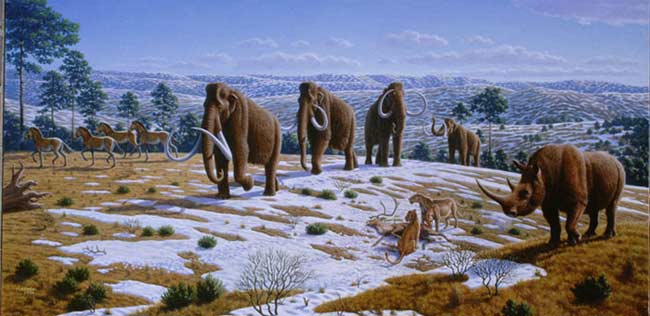Mammoth Mystery: The Beasts' Final Years

Woolly mammoths' last stand before extinction in Siberia wasn't made by natives — rather, the beasts had American roots, researchers have discovered. Woolly mammoths once roamed the Earth for more than a half-million years, ranging from Europe to Asia to North America. These Ice Age giants vanished from mainland Siberia by 9,000 years ago, although mammoths survived on Wrangel Island in the Arctic Ocean until roughly 3,700 years ago. "Scientists have always thought that because mammoths roamed such a huge territory — from Western Europe to Central North America — that North American woolly mammoths were a sideshow of no particular significance to the evolution of the species," said researcher Hendrik Poinar, an evolutionary geneticist at McMaster University in Hamilton, Canada. Real history To uncover the real history of woolly mammoths, Poinar and his colleagues spent the last three years extracting ancient DNA from 160 mammoth samples over much of their former range across Europe, Asia and North America, from which they assembled a family tree. Many scientists had thought woolly mammoths were essentially one big family connected across the roughly 1,000-mile-long Bering Land Bridge that once joined Alaska to eastern Siberia. Instead, the Bering Land Bridge might have been a significant barrier rather than an open corridor between the east and the west, as mixing between mammoths of the Old World and New World seems rare, the new research shows. The bridge might have been tundra-like and not good at supporting these large creatures, the researchers explained. These divided groups of woolly mammoths then diverged genetically to become distinct populations. Mysteriously, the Siberian mammoths then abruptly dwindled roughly 40,000 years ago, with American migrants replacing them rapidly, the study found. "Something really happened to those Siberian guys," Poinar said. "They literally fell off the face of the Earth and were supplanted by North American mammoths." These findings had eluded scientists in the past because such a genetic switch is "difficult if not impossible to tell by looking at teeth, tusks and bones," Poinar explained. While such population replacements are not uncommon on a small scale, "ones occurring on a continental scale certainly are," said researcher Ross MacPhee, curator of mammalogy at the American Museum of Natural History in New York. Mystery remains As to what led to this continental-level decline, "there is a very large unknown looming here," MacPhee said. He does not think competition between the different mammoth populations is a likely culprit. Human over-hunting also does not make sense. "You have humans in both Asia and North America at that time, but no drop-out in North America at that time," he added. "Disease of course immediately comes to mind, but we have nothing to go on for that yet." Evolutionary geneticist Régis Debruyne at McMaster University noted that "for more than a century, any discussion on the woolly mammoth has primarily focused on the well-studied Eurasian mammoths. Little attention was dedicated to the North American samples, and it was generally assumed their contribution to the evolutionary history of the species was negligible. This study certainly proves otherwise." MacPhee said: "Right now it seems that mammoths had a very complicated demise. Enormous crashes seem to be part of their story — this enormous crash in Siberia might have been a prequel for their final loss." Analysis of the DNA reveals the Siberian mammoths that the North Americans replaced might not actually have been woolly mammoths, Mammuthus primigenius, but another, more archaic species. On the other hand, the original Siberian mammoths might have been woollies that inherited DNA from other species from ancient hybrid ancestors, Poinar said. Further genetic analysis could reveal which possibility is true, "and maybe help identify certain genes that gave an evolutionary advantage somehow that allowed one of the mammoth populations to survive and the other die off," he added. Debruyne, Poinar, MacPhee and their colleagues detailed their findings online Sept. 4 in the journal Current Biology. Funding for this study was provided in part by Canada's Natural Science and Engineering Research Council, the International Human Frontiers Science Program Organization, Canada's Social Sciences and Humanities Research Council, the Canadian Research Chairs program and the Discovery Channel.
- World's Biggest Beasts
- Top 10 Beasts and Dragons
- Gallery: Creatures of the Wild
Sign up for the Live Science daily newsletter now
Get the world’s most fascinating discoveries delivered straight to your inbox.











